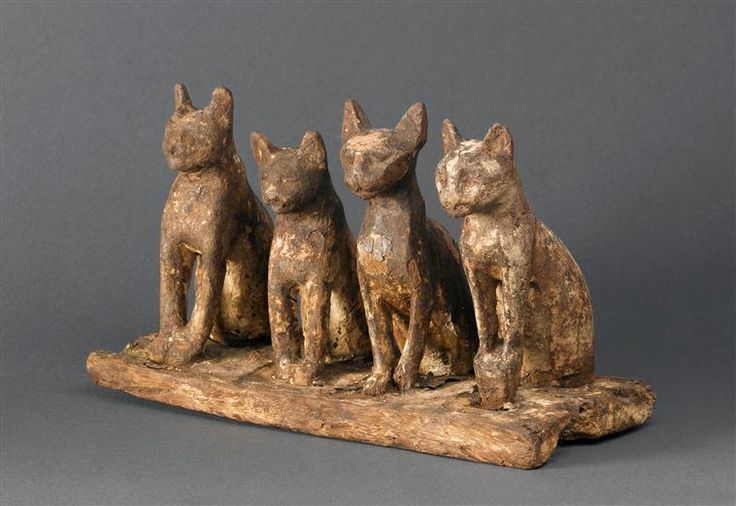Bastet, also known as Bast, was an ancient Egyptian goddess who originally had the role of protecting the Pharaohs. The inhabitants of the lower Nile depicted Bastet as a savage, lion-headed deity. After 1000 BCE, the Egyptians altered her image to the body of a woman and the head of a domesticated cat. Along with her change in appearance, she was also transformed into a peaceful and approachable deity. Instead of Bastet protecting Pharaohs, she was now a nurturer and protector of all households. Families soon began to invite cats inside their homes, thinking that they brought with them the spirit of Bastet. They worshiped these cats because they also hunted mice, snakes, and other pests that ruined their crops and their perishable goods. Bastet’s role as a goddess was further altered when she acquired the trait of fertility. Women would purchase pendants with Bastet and multiple kittens to enhance their fertility.1

Statues and depictions of Bastet vary. She transforms from a beast with a female lion’s head, to a woman with the head of a cat, to a regular black cat with kittens who sometimes held a rattle. Some thought the rattle was actually a musical instrument called a sistrum. Because of this, Bastet was also associated with music and dance. Soon after the sistrum was added to Bastet’s image, the Egyptians used the instrument at festivals where they would worship Bastet. Then, Bastet was depicted wearing a decorative dress, carrying the sistrum in her right hand and a shield in her left, with a bag over her arm.2
The Egyptians had an explanation for why she was transformed from a savage beast to a fertility and music goddess. Bastet was the daughter of Ra, the sun god who was vengeful. From him she got her aggressiveness. Her mother is unknown, but the Egyptians suspect that Ra sent young Bastet to Nubia as a lioness in isolation. There she was able to let out her rage, and then wander back to Egypt as a docile cat. Later an unknown king proclaimed that Bastet was his mother. Egyptian women then believed worshiping her would provide them with many children, as house cats would typically have up to twelve kittens; and one of her sons became king. Experts believe that the baby rattle was mistakenly interpreted as a sistrum, which led to her being known as a music and dance goddess.3

In depictions of wars on the walls of palaces, she was portrayed as a lion, and in homes she was a cat. Although Bastet was a goddess with many traits, that was not all that uncommon. In ancient Egypt gods and goddesses often served more than one purpose. Along with her most common traits, she was also thought of as the goddess of the sun, which she inherited from her father, as well as the goddess of physical pleasure. It was even believed that if a cat ran through a fire, the fire would be put out; therefore, she became the deity of firefighters.4
It is undeniable that Bastet was highly respected. Experts are still unable to determine when Egyptians first began to worship her as well as when her presence faded. Many statues of Bastet and mummified cats have been discovered along the lower Nile, which has led experts to believe that festivals were held there in her honor and locals worshiped her to the highest degree. Although she did have many roles, she is best known as the goddess of protection.5
“His totem animal in black onyx
erect on her haunches poised and aware
he brings in a dream that I might learn
cats are cats and gods—slit-eyed in the sun
in darkness with dilated iris she sees
protector I hope though at times in the night
I tense at her wild amorous cry…”
–Bastet 6
- The Salem Press Encyclopedia, 2o16, s.v. “Bastet (diety),” by Latha Iyer. ↵
- Kathryn Razavi, “The Lioness and the Kittycat: Egypt’s Great Feline Goddess” (Undergraduate Honors Thesis, University of Colorado, 2013), 20-25. ↵
- Nora Scott, “The Cat of Bastet,” The Metropolitan Museum of Art Bulletin, 1 (1958): 1. ↵
- Kathryn Razavi, “The Lioness and the Kittycat: Egypt’s Great Feline Goddess” (Undergraduate Honors Thesis, University of Colorado, 2013), 23. ↵
- Salem Press Encyclopedia, 2o16, s.v. “Bastet (diety),” by Latha Iyer. ↵
- Phyllis Stowell, “Bastet,” Psychological Perspectives 56, no. 3 (2013): 362-364. ↵



67 comments
Gabriela Serrato
It was so interesting to read this because I have heard of Egyptians adoration for cats but I was always unaware why, and this further explains as to why that might have been. I related this to how in my years of education, we learned extensively about the Greek gods and Goddesses, yet we never covered that in respect to the Egyptians. I hope more articles are written under this topic because it is definitely unique and unknown to me. I also began thinking of how cats have been domesticated, as a result of this and it is now prevalent in the United States.
Bailey Rider
This was a very interesting article! I had never heard of Baset before and it was interesting to learn of about all of the things that the Egyptian people looked to her for. It was also cool to learn and read about the transition the the Godess made over time with her many different forms and roles that she played. I especially like that she was seen as a Godess of fertility with the kittens! Thank you for such an interesting article!
Andrew Gray
Great article! It is very interesting how the cat goddess is transformed based on the type of situations humans face themselves. On one hand you have a lion protecting those in battle while on the other you have a house cat believed to enhance ones fertility. I enjoyed how this article was put together showing how the god was depicted differently over time.
Mariana Govea
Very well informative article! I really enjoyed the reading! I had never heard of this Egyptian goddess,but after reading the article I can say I really know who she was! You provided very good information on who she was and why the people loved her so much! Its crazy to know that these people saw one God as many different identities or that that one God provided the people with many different blessings!I find it so interesting how people related her to a cat or a lion, but why was that? Why did the people think the cats would help out with fertility? Was it just because she represented a cat and that is hwy or was there really a reason behind why it was a cat and not another animal?
Justin Sassman
I know nothing about any on the Egyptian gods, so when I started to read this article I found it very interesting, especially the fact that unlike many polytheistic gods she has multiple roles, like being a protector and goddess of fertility. also learning the story on how she got her many roles was very intriguing as well. A very good article.
Garrette Bradley
I like the article one thing that I found out by reading a book is that Ra sent Bastet to guard him every night during his trip to the Duat to give hope to the souls. He also sent her to keep Apophis at bay and not destroy his creation. But overall the article is informative and I still learned a lot from it that I didn’t know.
Cameron Adelman
Your article was very informative (it’s evident that you put in the research), but there’s some awkwardness in your sentence formulation that make the article hard to understand in a couple places. When your editing your articles, I recommend that you try reading aloud as you make revisions; if it makes sense when you say it out loud then it will make sense when other people read it on the page. Either way, I learned a lot from your article, so good job. I look forward to reading your next one.
Luke Trevino
I enjoyed this article because it is obvious how much research was put into the essay. I knew they worshipped cats but never knew to this extent! It is crazy how people would give baset different meanings according to what they wanted her to be. This goes to show that people will create things in their head to help them get through something in their life.
Alyssa Valdez
Very informative Article! I always questioned why the Egyptians were so fond of cats so I thought this article did a great job of explaining so. Additionally, I also thought your article was very organized in explaining the timeline of the Egyptians beliefs. I never really knew much about the Egyptians so learning about one of the gods was interesting!
Aimee Trevino
I really enjoyed reading this article! I liked how you went in order of how the Egyptians beliefs changed and added on over time. The Egyptian civilization has always interested me, so to read an article on one of their beliefs only adds to it. I knew they worshipped cats, but never knew they would go so far as to mummify them. Overall, really interesting!